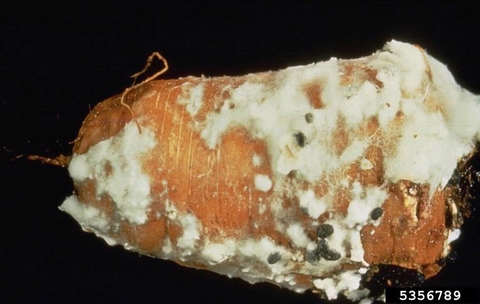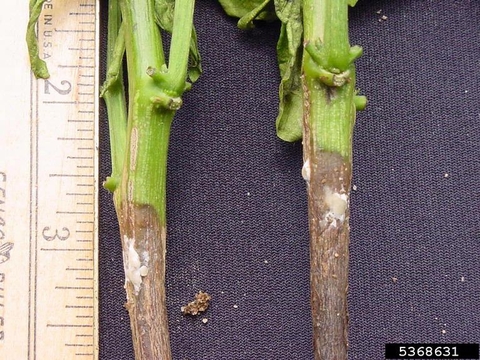Quick facts
- White mold severely affects pumpkins and some varieties of winter squash.
- The disease infects both stems and fruit.
- White mold often infects pumpkin through the blossom end of the fruit.
- Stem infections start where cotyledons are fading or where the plant has wounds.
- No resistant varieties are available, but plants with an open growth habit have less disease than plants with dense leaf coverage.
- Use wide row spacing, control weeds and plant rows parallel to the prevailing wind to promote rapid drying of plant leaves.
The fungus Sclerotinia sclerotiorum causes white mold. This pathogen infects a wide variety of vegetable crops including beans, carrots, tomato, cabbage and lettuce.
In the cucurbit family, the disease severely affects pumpkins and some varieties of winter squash.
This disease does not cause leaf spots, but infects both stems and fruit.
Identifying white mold symptoms
- Infected fruit and stems first appear water-soaked.
- Fluffy, white, cotton-like fungal growth is common on infected areas.
- Small, hard, black, raisin-like fungal structures, known as sclerotia, eventually develop, embedded in the cottony mold.
- White mold often infects fruit through the blossom end. They become rotted and watery. Sclerotia may be present inside the rotted fruit.
- Rot may occur in the field or post-harvest.
What causes white mold
The white mold fungus form hard black resting structures (about the size of a raisin or smaller in cucurbits) called sclerotia that allow them to survive in the soil and plant debris for five or more years. The sclerotia produce small mushroom-like apothecia that release spores under cool wet weather conditions.
White mold often infects pumpkin through the blossom end of the fruit, especially when the blossom remains attached after pollination.
Stem infections start where cotyledons are fading or where the plant has wounds.
Preventing and managing the disease
- No resistant varieties are available, but plants with an open growth habit have less disease than plants with dense leaf coverage.
- Use wide row spacing, control weeds, and plant rows parallel to the prevailing wind to promote rapid drying of plant leaves.
- If white mold has only infected a few plants, remove those plants from the field before sclerotia form. Bury them deeply.
- Do not compost infected fruit or other plant material.
- Rotate crops to corn or other grasses to limit or reduce pathogens in the soil.
Reviewed in 2021



